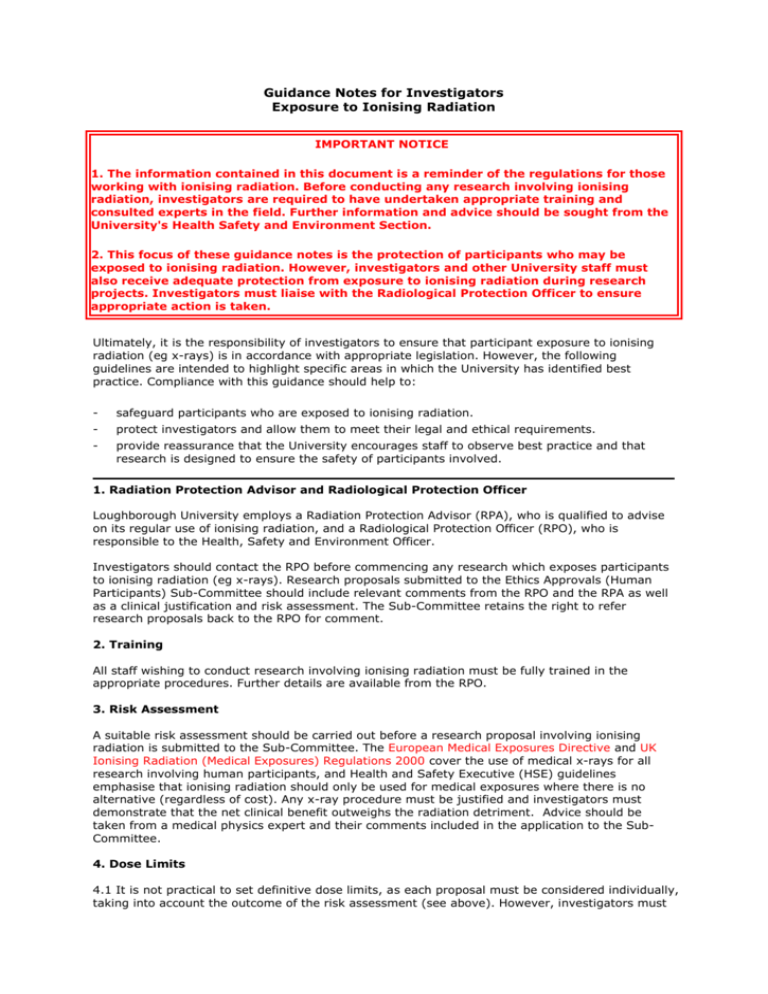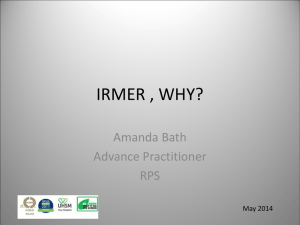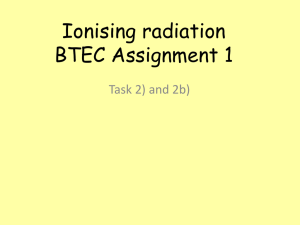Exposure to Ionising Radiation
advertisement

Guidance Notes for Investigators Exposure to Ionising Radiation IMPORTANT NOTICE 1. The information contained in this document is a reminder of the regulations for those working with ionising radiation. Before conducting any research involving ionising radiation, investigators are required to have undertaken appropriate training and consulted experts in the field. Further information and advice should be sought from the University's Health Safety and Environment Section. 2. This focus of these guidance notes is the protection of participants who may be exposed to ionising radiation. However, investigators and other University staff must also receive adequate protection from exposure to ionising radiation during research projects. Investigators must liaise with the Radiological Protection Officer to ensure appropriate action is taken. Ultimately, it is the responsibility of investigators to ensure that participant exposure to ionising radiation (eg x-rays) is in accordance with appropriate legislation. However, the following guidelines are intended to highlight specific areas in which the University has identified best practice. Compliance with this guidance should help to: - safeguard participants who are exposed to ionising radiation. - protect investigators and allow them to meet their legal and ethical requirements. - provide reassurance that the University encourages staff to observe best practice and that research is designed to ensure the safety of participants involved. 1. Radiation Protection Advisor and Radiological Protection Officer Loughborough University employs a Radiation Protection Advisor (RPA), who is qualified to advise on its regular use of ionising radiation, and a Radiological Protection Officer (RPO), who is responsible to the Health, Safety and Environment Officer. Investigators should contact the RPO before commencing any research which exposes participants to ionising radiation (eg x-rays). Research proposals submitted to the Ethics Approvals (Human Participants) Sub-Committee should include relevant comments from the RPO and the RPA as well as a clinical justification and risk assessment. The Sub-Committee retains the right to refer research proposals back to the RPO for comment. 2. Training All staff wishing to conduct research involving ionising radiation must be fully trained in the appropriate procedures. Further details are available from the RPO. 3. Risk Assessment A suitable risk assessment should be carried out before a research proposal involving ionising radiation is submitted to the Sub-Committee. The European Medical Exposures Directive and UK Ionising Radiation (Medical Exposures) Regulations 2000 cover the use of medical x-rays for all research involving human participants, and Health and Safety Executive (HSE) guidelines emphasise that ionising radiation should only be used for medical exposures where there is no alternative (regardless of cost). Any x-ray procedure must be justified and investigators must demonstrate that the net clinical benefit outweighs the radiation detriment. Advice should be taken from a medical physics expert and their comments included in the application to the SubCommittee. 4. Dose Limits 4.1 It is not practical to set definitive dose limits, as each proposal must be considered individually, taking into account the outcome of the risk assessment (see above). However, investigators must demonstrate to the Sub-Committee (and the University) that the dose calculated at the risk assessment stage will not be exceeded. It may be useful for investigators to bear the following details in mind when considering appropriate dose levels: The Ionising Radiations Regulations 1999 (IRR1999) define the maximum dose limit for the general public as 1 mSv (1000 µSv) per annum. Annual background ionising radiation, to which everyone is exposed, is 2200 µSv (2.2 mSv). The University understands the above recommendation (in the IRR1999) to apply to radiation over and above the annual background radiation. 4.2 Wherever possible, ionising radiation should be limited to only necessary scans. Unnecessary scans should be avoided. 4.3 If subsequent exposures (eg follow up studies) are unavoidable, investigators should ensure that an appropriate period elapses between radiation doses. The suitable time period will vary depending on the purpose of the study. Some general guidance which investigators may find useful is as follows: > 6 months for most bone studies. 2-3 months for body composition studies. In all cases, investigators should justify the follow-up period and where appropriate seek advice from the RPO. This is particularly important where the same participant is exposed twice over a short period in order to determine the precision of the measures taken. 4.4 When conducting research involving ionising radiation, which is unrelated to previous studies, investigators should aim to avoid recruiting the same participants on multiple occasions. 5. Monitoring and Recording Exposures All exposure to ionising radiation must be explicitly monitored and recorded in departmental records. A radiation monitoring service recommended by the HSE must be used to assess exposures. 6. Equipment and Supervision All exposure to ionising radiation should be supervised by a qualified "expert". The University's preference is for research involving the use of x-rays to be conducted off-campus. For on-campus scans, the HSE must be informed, and rigorous safety checks carried out (see below). Off-Campus If exposures are conducted off campus, for example in a hospital, the investigators should arrange for experienced personnel to operate equipment and oversee procedures. On-Campus Work carried out on campus involving the use of medical x-rays falls outside the University's authorisation for the use of x-ray generating equipment. The University is required to give the HSE 28 days notice of any change to its working pattern. Therefore investigators must contact the RPO well in advance if they wish to use x-ray equipment on campus. The University has a responsibility to ensure that any x-ray generating equipment brought onto campus is fit for purpose, and has current test and calibration certificates, and that all staff operating the equipment are suitably trained. If you intend to bring a portable x-ray device onto campus, you MUST contact the RPO to ensure that the appropriate safety checks have been conducted and that suitable arrangements are in place for operation and supervision of the procedure. In addition the HSE require a proven management structure for the use of x-ray generating equipment. Overall responsibility rests with the Head of Department but departments will also need to appoint a suitably trained Radiation Protection Supervisor for their area to oversee procedures. If the research is conducted off-campus the requirement for a proven management structure is the responsibility of the "host" location. 7. Participants 7.1 Informed Consent - All participants should be fully informed of any risks associated with exposure to ionising radiation. Full consent should be obtained. 7.2 Exclusion Criteria - Wherever possible, the University advises investigators not to include pregnant women or children in research projects involving exposure to ionising radiation. However the University acknowledges that there will be occasions where important research involving these populations is necessary and would not seek to discourage investigators from pursuing this. Investigators will, however, be expected to justify their choice of participants in line with the objectives of their research. As in any research proposal involving ionising radiation, a suitable risk assessment should be conducted and dose limits justified to the Sub-Committee with supporting evidence from a medical expert. Appropriate medical screening should be conducted to ensure that participants: do not suffer from any medical conditions that would be adversely affected by exposure to ionising radiation. have not been subjected to high levels of ionising radiation exposure (eg hospital treatment) on previous occasions. are not regularly in contact with ionising radiation (eg work environment). 7.3 Duty of Care - During the course of an investigation, investigators may identify participants with abnormal results. Investigators are advised to explain to each participant at the beginning of the study (before any x-rays have been taken) that if any abnormal results are found, the nature of the abnormality will be explained. Once any abnormalities and implications have been fully explained, the participant should be asked to consent to the information being passed to their GP. Investigators must NOT: - give clinical advice or - pass information to GPs without the participant's informed consent. 8. Further Information The above is not intended to be an exhaustive list of considerations in relation to the exposure of participants to ionising radiation during research projects. However, it is hoped that these guidelines will encourage researchers to adopt best practice and familiarise themselves with the relevant legislation. The following websites may also be of interest: The Ionising Radiation Regulations 1999 UK Ionising Radiation (Medical Exposures) Regulations 2000 European Medical Exposures Directive Ionising Radiation Procedures at Loughborough University HSE Radiation Doses HSE Portable Monitoring Equipment HSE Guidance Note PM77 - Equipment Used in Connection with Medical Exposure Radiation Safety Website Directory







